- Getting around Lijiang. Dont stay in the Old Towns more than 2 days, there is nothing to do. KRISS Oct 9, 2013 05:46
- 2013 Beijing Temple Fair BENNYLAU Feb 26, 2013 03:29
- Malaysian traveling from KUL - LAX vis Shanghai PVG ZATI_DY Jan 3, 2013 20:15
Jinan's 1000 Buddha Mountain
- Views: 9193
- |Vote: 0 0
- |Add to Favorites
- |Recommend to Friends
Capital of Shandong
Capital of Shandong Province (山东省) it may be, but Jinan (济南) really doesn’t rate highly on the travellers itinerary. It is at best placed fourth, if it rates at all: dwarfed by the ultra-famous Mount Tai (泰山); culturally out-gunned by the birthplace of Confucius at Qufu (曲阜) and just plain boring in comparison with the beer-festival’d, ocean-fronted, Bavarian-styled minion Qingdao (青岛).
I sympathise with Jinan much as I do with underdogs in any situation and this is usually more than enough to get me interested. The least attractive places are generally less peopled and all the more “real” for it.
In any event, the reality was that in January this year I had just finished climbing Mount Tai and had a couple of days to spare. Money and time conspired against heading out to Qingdao, and Jinan seemed the next logical choice. A Shandong-born friend met up with me and discounted my original plan to explore the natural “Springs” the city is known for: too tacky and expensive, we concluded. Instead we started talking about Buddhas and mountains and that was that: exploring Qianfo Shan (千佛山) or 1000 Buddha Mountain became our goal.
Impressions of Jinan
Arriving in Jinan on a bright, crispy winter’s morning so typical of the North East, is pleasant enough. The main bus station, a short ride out of the city, is clean and thrumming with pre-Spring Festival crowds and there’s a general upbeat mood that’s contagious. Maybe it’s the sun streaming through the taxi windows or the driver’s jovial banter but we are in high spirits.
We find a grubby looking hotel with a warren-like interior and settle on the small twin room with two essentials: heating and hot water (from 7pm till 10am). Tucked behind the train station, it’s well situated on the bus route to Spring City Square (泉城广场) and from this central square it’s easy to orientate yourself and navigate to the various places of interest.
Around the corner from the hotel is a fabulous little place, a cross between a cafe and a fast food joint. It has 6 tiny tables and is clean, cheap and warm. The cafe bustles with customers and it is a pleasure to sit and practice my Chinese listening to their standard putonghua (普通话). The vegetable baozi (菜包) here are delicious and we become breakfast regulars on them, along with rice porridge (粥) and my favourite sweet bean milk (豆浆).
The public transport, as elsewhere in China, is cheap, reliable and busy. The streets we pass through are narrow and edged with hundreds of trees whose bare branches lie against the sky like cracks on an icy lake. In summer I can imagine their canopies casting welcome shade and bringing the city to life in greens. At night their bare branches are lit prettily with hundreds of white fairy lights.
Beyond these quieter suburbs, the city proper begins to assert itself. It is much taller than I’m used to and the buildings are of the modern glass and concrete constructions found all over China. In the evenings they display huge silent advertising screens that scroll the same images over and over.
Spring City Square is a vast plaza in the centre of the city. This chilly Sunday it is thriving and we wander around people watching and taking in the cityscape. A tall squiggly sculpture of pale blue and silver dominates the square and at the far end is a huge lotus flower fountain, behind that stands a semi-circle of statues of the many famous people who were born in this city. We buy a couple of tanghulu (糖葫芦) - the Chinese equivalent of toffee apples - and sit down to watch the old men with sticks and string who are playing with diabolos, and those with kites that are flying so high that they are like specs of coloured dirt on the sky’s lens and between them all the children that swirl in and out on roller blades.
Daming Lake (大明湖)
We queue for ages to buy our tickets to enter the park that seems unreasonably busy. It is only after waiting for 10 minutes or so that we realise we are queuing for locals-only season tickets and that in fact the small, empty window is the one we should be buying our tickets from.
Daming Lake is worth a mention as it makes a relaxing place to stroll and it is one of those precious places where you can escape from the grind of the city. There are many temples and pavilions scattered around its banks. The lake itself covers an area of 460,000m2 and it’s formed where Jinan’s 100 natural springs converge. Also within its boundaries are a museum of precious stones and minerals, an amusement park and numerous small stalls selling paintings, tea sets and other tourist souvenirs. Boats criss-cross the lake ferrying passengers to and fro and making stops at some of the little islands. In the summer you can hire a boat or sit out at one of the teahouses admiring the weeping willows and the dinner-plate lotus blooms.
This winter’s day Daming Lake is indeed living up to its literal translation, big and bright, the sunlight glinting wickedly off the waters and throwing the city into hazy silhouette. We take a ride in the big wheel and hire a pair of binoculars to get excellent views out over the lake, Jinan and beyond.
1000 Buddha Mountain (千佛山)
1000 Buddha Mountain’s history is almost as old as China’s itself. Legend has it that Yushun (虞舜), a Chinese emperor from pre-history, used to farm at the foot of this mountain. Yushun was one of the five emperors existing before the first acknowledged dynasty (the Xia) was founded in around 2100BC.
Mountain is a bit of a misnomer, for what is actually a hill, considering that 1000 Buddha Mountain rises a modest 285m above sea level; although the surrounding area is so low that it appears to command a much grander height. As long ago as 581AD, during the Sui Dynasty, people began carving Buddhas into the hillside and 1000 Buddha Monastery (now called Xingguo Monastery) was built. The mountain subsequently became known as 1000 Buddha Mountain.
During its time, 1000 Buddha Mountain has witnessed many changes and increased in popularity. It was to host marvellous temple fairs during the Yuan Dynasty (1279-1368) and the original monastery was enlarged during the Ming Dynasty (1368-1644) establishing the site as a major pilgrimage destination. 1000 Buddha Mountain flourished under Buddhism “booms” created when the ruling emperor was a believer, and languished in solitude in-between times. Sadly it suffered many of the original carvings and statues to be mutilated or destroyed during the Cultural Revolution, but since then efforts have been made to restore and “restock” and the park now covers 166 hectares and makes for a full day’s exploration.
The Impressive Wanfo Cave (万佛洞)
The opening to this 500m long cave is presided over by a scaled-down version of Leshan’s magnificent Buddha, this sets the scene for things to come. Wanfo Cave replicates over 28,000 statues found in four of the most famous sites in China: the Mogao & Maiji Caves in Gansu (甘肃); the Longmen Grottoes in Henan (河南) and the Yungang Caves in Shanxi (山西). The thousands of statues range from tiny carvings on the cave walls, to a 28m long reclining Buddha.
The cave is impressive and I can only imagine how powerful wandering the original sites must be – this surely is the next best thing. Aside from the floor, every visible space is decorated with carvings, statues and paintings that cover artistic styles ranging from the Northern Wei (北魏) to the Ming (明) Dynasties: almost a millennium! The cave’s atmosphere is suitably imposing, dark, cool and the maze-like unfolding of chamber upon chamber makes me feel like Indiana Jones exploring some ancient, undiscovered tomb.
Paying the Price: Karma or a Tourist Scam ?
A smaller cave can be found nearby and my Chinese friend manages to sneak us both in for the student price of just 2RMB. I feel a little guilty and am later to regret it, but perhaps this is “karma”. The cave itself is disappointing, compared with the grandiose Wanfo, it is bare except for a range of jade statues of Buddha in various poses that sit along the edges of the path. As we reach the end of the statues we come to an inner cave, curtained off and designed like a temple. I see a man hastily pull on a robe and hurry out and when we arrive at the entrance a “monk” is ready to greet us.
He invites us in beyond the curtain, murmuring incantations and ringing a small bell much as I have seen monks practise in genuine temples throughout China. He asks us to kneel and my friend is translating that he wants to bless us. I protest because I am not a believer, but the monk continues, taking a large incense stick with a 70RMB price tag on it from off a rack. He bades us close our eyes and swings an amulet of incense over us and I am beginning to feel a little strange. Another man is sitting silently in a booth, watching.
I am wondering who is going to pay for the incense and as the monk prepares to open it, I tell him to stop. Something in my gut tells me this isn’t right. My Chinese friend is a little embarrassed and the monk seems none too pleased, but I reaffirm in Chinese that I do not want to be part of this ceremony.
The man who has up until now been silent steps in, smiles graciously, and asks me to sit and rest. He takes my Chinese friend by the arm, ushers him into the booth, and the two of them start talking heatedly. The monk appears oblivious and continues to circle the space ringing his bell and wafting incense.
It is only after a “donation” of 10RMB that the man finally lets us leave and my friend tells me that the man asked him to write in English in a book something along the lines of “visitors wishing to be blessed must pay 200RMB” or face some kind of “divine” recriminations. It is a scam. My friend glances at me and his eyes are twinkling: “I didn’t write that” he said. In fact, he’d had the presence of mind to write a warning there to all foreign tourists to be careful and not to feel obliged to give any money.
At the End of the Day: Smile
It’s impossible to detail all the small sites within the 1000 Buddha Mountain Park: this is a place to wander and happen across gardens, sculptures and tiny temples.
The Maitreya Holy Yard displays a huge golden Maitreya figure that dominates the surroundings, his smile as wide and sumptuous as his stomach. There are temples and pavilions scattered all over, as well as archways and decorative steles of historical interest. The Yujingchan Archway, at the west gate of the Xingguo monastery, was built during Qianlong’s reign and is particularly pretty: its poetic inscriptions written in gold against a red background. The monastery itself, located part way up the hill, feels its age. It stands between rocky walls with gnarled tree trunks towering over it; incense and the quiet feet of monks drifting through it.
We make our way up to the top of 1000 Buddha Mountain to a small pavilion hoping to see the fast approaching sunset. The city of Jinan sits under a haze of industry and early evening cloud, its buildings and cars fighting their way through the murk to our eyes one light at a time. The sun becomes an orange globe and sinks, the temperatures along with it, reminding us that winter in Jinan is certainly cold. We wrap up against the sub-zero evening and head back towards the city.
At the end of the day, we put the scam in perspective and smile about it happening to us so that perhaps we could do future visitors a favour: it is both intolerable and laughable. The Maitreya figure is still grinning enough to swallow the whole world; the last rays of sun having glanced off his golden shell. The park’s guidebook’s English translation reads:
“A big stomach tolerates
Intolerable things
A big smile laughs at laughable people”
Information (January 2007)
Getting there
From: Hangzhou (杭州)
To: Jinan (济南)
By: overnight sleeper bus
Cost: 220RMB
Daming Lake (大明湖)
Entrance Fee: 30RMB per person
Big wheel: 10RMB per person (2RMB to hire binoculars)
Stone museum entrance fee: 6RMB per person
Getting there: can be reached on foot, 15 minutes or so, from Spring City Square (泉城广场)
1000 Buddha Mountain (千佛山)
Entrance fee: 30RMB per person
Guide book: 10RMB (in reasonable English & Chinese)
Wanfo Cave: 15RMB per person
To enter the small temples, usually between 2-5RMB per person
Getting there: take the number 66 bus from Spring City Square (泉城广场)



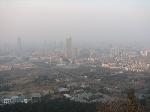

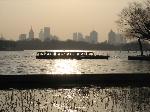
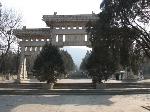
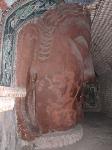
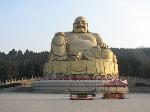

 Copyright © 1998-2026 All rights reserved.
Copyright © 1998-2026 All rights reserved.